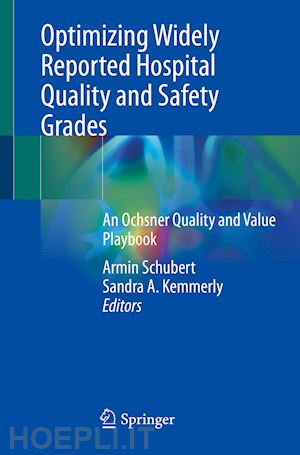
Questo prodotto usufruisce delle SPEDIZIONI GRATIS
selezionando l'opzione Corriere Veloce in fase di ordine.
Pagabile anche con Carta della cultura giovani e del merito, 18App Bonus Cultura e Carta del Docente
This practical, engaging book provides concise, real life-tested guidance to healthcare teams concerned with widely reported and incentivized hospital quality and safety metrics, offering both a conceptual approach and specific advice and frameworks for reviewing quality and safety numerator events, from the perspective and experience of clinicians and administrators working within the Ochsner Health System.
The text opens with the rationale for closely managing widely (including publicly) reported hospital patient quality and safety measures. Attention is given to the financial implications of quality performance, with respect to both penalties and payment incentives used by payer organizations. It then reviews the major public ratings and their relevant methodologies, including CMS, AHRQ and NSHN. In addition, it addresses ratings by proprietary organizations that have a large member clientele, such as Vizient, USNews, Leapfrog, Healthgrades, CareChex and others. Each metric - for example, the AHRQ Patient Safety Indicators (PSIs), and other metrics such as readmission rate, risk adjusted complications, hospital-acquired conditions and mortality - is addressed in a stand-alone chapter. For each, the importance, approach to review, opportunity for optimization, and engagement of healthcare staff are reviewed and discussed.
Overall, this book forefronts the benefits of a collaborative approach within a health system. The concurrent review process, multidisciplinary collaboration among quality improvement, clinical documentation, coding and medical staff personnel are all emphasized. Also described in detail is the approach to and specific opportunities for medical staff education and engagement. Additional key topics include Engagement of the Medical Staff and House Staff (i.e., residents and other trainees), Futile Care, Surgical Quality Improvement (NSQIP), Nursing Provider Partnership, and Translation of Data Review to Successful Performance Improvement. Specialty chapters on pediatric, neurologic and transplant quality metrics are also included.
Armin Schubert, MD, MBA, CPE, Vice President of Medical Affairs, Quality and Patient Safety, Ochsner Medical Center, New Orleans, LA, USA
Sandra A. Kemmerly, MD, MACP, FIDSA, System Medical Director of Hospital Quality, Ochsner Health, New Orleans, LA, USA











Il sito utilizza cookie ed altri strumenti di tracciamento che raccolgono informazioni dal dispositivo dell’utente. Oltre ai cookie tecnici ed analitici aggregati, strettamente necessari per il funzionamento di questo sito web, previo consenso dell’utente possono essere installati cookie di profilazione e marketing e cookie dei social media. Cliccando su “Accetto tutti i cookie” saranno attivate tutte le categorie di cookie. Per accettare solo deterninate categorie di cookie, cliccare invece su “Impostazioni cookie”. Chiudendo il banner o continuando a navigare saranno installati solo cookie tecnici. Per maggiori dettagli, consultare la Cookie Policy.